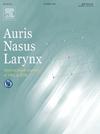Vestibular nerve neurectomy: Functional and histopathological outcomes in the cochlea of guinea pigs
IF 1.6
4区 医学
Q2 OTORHINOLARYNGOLOGY
引用次数: 0
Abstract
Objectives
Experimentally test the effect of vestibular nerve neurectomy on the function and histopathology of the cochlea.
Methods
The study was conducted on 20 normal male adult pigmented guinea pigs (Cavia porcellus). First, each animal was tested with Distortion Product Otoacoustic Emissions (DPOAEs) preoperatively then vestibular neurectomy (V.N) was performed on the right side through suboccipital modified retrosigmoid approach. We tested the DPOAEs postoperatively; After 8 weeks, Guinea pigs were euthanized the cochlea of guinea pig was processed for light microscope and transmission electron microscope examination to observe the outer hair cell count, and spiral ganglion cell density in the operated ear compared to contralateral non operated cochlea of the same guinea pig.
Results
There was a significant decrease in spiral ganglion cell density in the operated side compared to the non-operated side. However, there was no significant difference in outer hair cell count or DPOAEs between the two sides, except for a significant increase in DPOAEs at 2 KHz in the operated side.
Conclusion
The results suggest that vestibular neurectomy may affect spiral ganglion cell density but not necessarily outer hair cell count or DPOAEs, and the relationship between these variables is complex and could be frequency-dependent.
求助全文
约1分钟内获得全文
求助全文
来源期刊

Auris Nasus Larynx
医学-耳鼻喉科学
CiteScore
3.40
自引率
5.90%
发文量
169
审稿时长
30 days
期刊介绍:
The international journal Auris Nasus Larynx provides the opportunity for rapid, carefully reviewed publications concerning the fundamental and clinical aspects of otorhinolaryngology and related fields. This includes otology, neurotology, bronchoesophagology, laryngology, rhinology, allergology, head and neck medicine and oncologic surgery, maxillofacial and plastic surgery, audiology, speech science.
Original papers, short communications and original case reports can be submitted. Reviews on recent developments are invited regularly and Letters to the Editor commenting on papers or any aspect of Auris Nasus Larynx are welcomed.
Founded in 1973 and previously published by the Society for Promotion of International Otorhinolaryngology, the journal is now the official English-language journal of the Oto-Rhino-Laryngological Society of Japan, Inc. The aim of its new international Editorial Board is to make Auris Nasus Larynx an international forum for high quality research and clinical sciences.
 求助内容:
求助内容: 应助结果提醒方式:
应助结果提醒方式:


